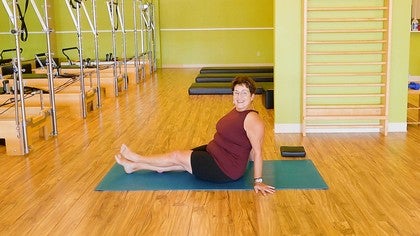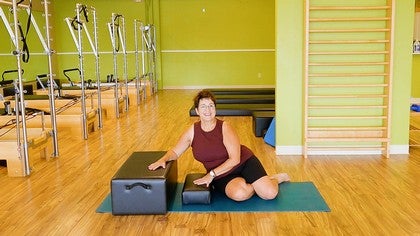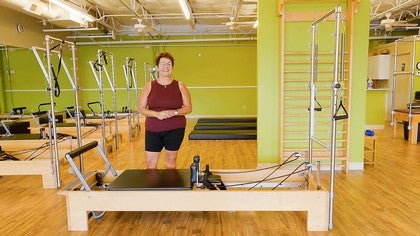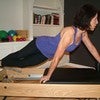Description
About This Video
Transcript
Read Full Transcript
In this tutorial, I'm going to demonstrate a couple of exercises that I have found if we don't try to instill patience as part of the practice of these exercises, sometimes they can lead to injury and injury doesn't mean it's life threatening or something like that, but injury in terms of, you know just kind of gripping and hanging on versus maybe waiting for the tension to build, or perhaps going too fast makes the carriage bounce and things like that. So a couple exercises that I'm going to demonstrate are in kneeling. So the first exercise that I'm going to demonstrate is kneeling chest expansion facing back. And I typically have a red spring on, but I'm gonna show you what happens if a client has a blue spring on, because they don't feel like they're strong enough to pull the red spring. You can already guess, you know, what's gonna happen.
Just when I climb on that sometimes we get already, we pull, but we find that the carriage, wee, it just kind of gets going and then before you know it, they kinda lose a connection and lose the tone in their front of their body. Now, as a challenge, you can use this light spring to build stability, but it all depends on what that client is doing. So we have to teach patience that we need to build this tension whether it's a light spring to build the tension, right? Or whether it's a heavy spring. So now I'm gonna leave the blue spring on and I'm going to add a green one.
So now I have, myself, I feel like I'm in really good shape today. I really wanna pull a really heavy spring and then I start to pull and I can get it back, but I get all outta whack. And then that, too much of a heavy spring, can make my neck come into play. So if I want a heavier spring, I need to know that I have to take time I have to build that tension through my finger flexors, right? My triceps, the back of my arms, my lats, I need to grow up through the crown in my head and I need to release just as slow because if I take the tension, whoa, and then I come back, then that can happen like that.
Somebody can fall forward, lose tension that way. So patience in the tension category, whether the tension is light or whether it's heavy, because I'm all for a light spring to build stability challenge and all for a heavy spring to build a strength challenge. I tend to teach those exercises first working the posterior part of the body postural shoulder exercises and posterior postural connections to keep us that way. So kneeling facing front is going to be the same thing in terms of the spring. So again, I typically, myself, start with a red spring and depending on where my straps are on that day, I don't start this exercise until I am really kind of relatively level with my humorous bone, or my arm bones, by my ribs.
And then I'm gonna serve my tray out and I'm gonna serve out and then I'm gonna share with my friends and then I'm gonna bring it back in and then bring it home. So that red spring for me creates, oh just a nice challenge for stability and strength. But in this exercise, again, if it becomes too light and I take this spring, right? And I pull it too fast, you know, and I get going, I'm not even gonna do it wrong 'cause it just feels like we're gonna fall, but as a stability challenge, we have to take time and stretch the springs out, taking patience even though the spring is lighter, right? We still need the patience to keep the tension.
So again, impatience can lead to injury oftentimes. Or maybe not injury, maybe just discombobulation or something like that. And then also in this one, if I put on say a green in a blue and I have to fight with it a little bit, let's see what happens. So now I have to push, right? And open so I have to take time.
I have to keep that tension the whole time. And actually this feels pretty good in terms of strength and then down. So, again, the speed has to kind of match the springage there. So those are two kneeling exercises with our arms that we have to be patient to build the tension. The other kneeling exercise that I need to pick on for just a second, is this kneeling exercise facing front.
Typically it's on a light spring, because we wanna build this quadruped feeling in the front of our body, right? So this kneeling abdominals facing front. So my head is in line with my spine, right? And I'm gonna push the carriage out with my arms and then pull it in and then I'm gonna leave my arms still and push out with my legs and pull it in. And then I'll do arms and then legs and then legs and then arms.
Now, sometimes I've seen this exercise be attempted with no spring. I'm not a fan of the no spring exercise, I'll just be very clear with that, that's just me personally because there's no help at all to bring the carriage in. So I am not going to demonstrate that, but I am gonna say that when you do that exercise yourself or you're practicing keep tone in the front of your body as you push the carriage out and as you bring it in. The next exercise that I want to build in terms of safety, it actually starts to become a progression. And sometimes, myself included, I've come in and I've seen somebody pull out a nice inverted like snake exercise, you know where you're in like a pike on top of the carriage.
So I'm gonna do this with this little box on this side of the carriage. And I actually have one green spring on, but that's for me and for my size body I need a little more help coming back in. If somebody that was really tiny had a green spring, it would be really hard to push it out. So know your spring tension for the body size and shape that you're working with. Understanding that the exercise called snake is in a pike position, right?
Where the body travels out into extension and then it comes back into flexion. So it's kind of like a moving cat cow if you will. So I'm gonna bring myself up on this box and I'm gonna take the position. The typical position here, my head starts nodded in and my low back is lifted and my spine is in flexion. I push my feet down as I take my chest forward and I arch my chest up.
My legs are tight. My head nods. I pull my abdomen up to bring myself in. Now I'm gonna go from a green to a red because I thought that green spring gave me too much help today. So now I'm going to a red spring.
Tummy in up into a pike coming over. Now I have to be patient with the speed to build the tension. My head is nodded. My low back is lifted. I take my journey out.
I bring my pelvis forward. I arch my chest up, much more of a challenge. And then I nod my head, bring my rib cage up and then come back. So snake is another one of those exercises where we have to get the shape and the feeling, okay? Patience.
The next part of that exercise is I have the carriage, the foot bar down and now I'm gonna work on the lifting part, right? So now I'm gonna take my, my foot here, right? As if I'm getting ready and my hands here. And I'm just going to lift and lower. I'm gonna put on a heavy spring again to hold the carriage kind of still.
And then I'm gonna ask myself, I wonder if I can hop my leg up. And then I wonder if I can hop my leg down. I wonder if I can hop up and then down. And then that hopping up and down actually becomes part of the exercise, right? And then I'm upside down in my pike.
And then I can progress that on. I'm not going to progress that today because I'm not ready to do that today, but I wanted to show you how the front part progression, in the chest, the bottom part progression, lifting the leg. All right? The other, the next exercise is kind of similar in the pike action. And I use this quite a lot to take the time to build the tension without the spring.
So the hands will come to the side of the reformer and I nod my head, I pick up my bottom and I get in this tendon stretch position. See, so that I push my arms, but I pull my ribs back because this tendon stretch position is in a flexed posture. And this will also become leg pull face up with your hands on the shoulder rests. Another exercise that requires patience and wrist and arm strength as well. So I press down, scoop in, lift up.
Now I'm gonna bring my feet back towards the wood and lift up, and then I'm gonna bend and not touch my bottom and then press back up. I'm gonna bend, I'm trying to stay in a pike shape, and then press back up and then one more time and then come up and then rest. That is a great way to get the shape and the feeling. Now for one leg, I take both of my hands, one on the outside of my thigh, one on the inside. I stand up and I feel my, my calf against the wood of the carriage and I take my other leg out.
So I feel the challenge of pressing down trying not to get like too far over like this. You see? So I have to be patient to take time to build that tension here. And this exercise becomes just as important as the one with the spring. And then I can lift, three, nod my head, scoop my belly, four and five, come down, have a seat.
Sometimes the building up to the exercise with patience is just as hard as the exercise itself. Switch hands. Well, I shouldn't say the exercise itself, because really they're all, they're all exercises. Okay, up we go. Hands down.
When I first lift the leg, I feel myself wanna shift way over. So I have to kind of get that connection up through this hip, touching my calf to the reformer. And then I lift up and up, pushing down on my hands, lifting up the back of my rib package here, two, one and then lower down and rest. Patience to build up the exercise to the next level. So it's okay to do things as you progress that are pieces of the new thing to be done.
The next exercise that I'd like to do is a version of front splits. And a lot of times just standing on the reformer itself becomes just a little shaky just cause it's up off the ground, right? So working on our splits then, we keep the one knee down. So what am I on the springage here? I'm on a red and a blue.
I'm gonna take my front leg out to the platform. And now my shin has this foot bar here, right? To press into. I'm gonna check in with my shoulders, my back toes. I'm gonna tighten up the tummy here.
Head is in line with the spine. Now the first piece of it, I'm gonna push my right shin away from the bar and then pull myself in. Then I'm gonna lift my back knee and push my leg away from the bar, but not my right shin. And then pull it in and come down. Because that will turn into front split standing, but right now I'm just getting the feeling.
Front leg pushes returns, hover, back leg pushes, returns. Both legs push and return. Both legs push and return and then come down. I'll do that on the other side. So this exercise or movement or pre movement or fundamental build up of the front splits, I want my sacrum to be relatively level, front shin pushes away.
Then it pulls back, gives me feedback. Then the back knee lifts, it pushes away. It comes back in, lowers down. Front shin. Shin stays in the front.
Patience with the back leg pushing and then coming in and then both legs. Both legs press, both legs pull. Both legs press, both legs pull, and then relax down. So those are some very traditional exercises that require patience. Taking time to build up a load or watching the different types of load with the springs.
There's another exercise that I'd like to do. And it's called the breaststroke and the breaststroke is such a pretty exercise, but first of all, if you don't have the ability to bring your arms all the way by your ears it will be hard to lift your body up and circle around. Very traditionally when we do this exercise, oftentimes somebody pushes the feet down in the back, but one of my favorite things to build up here to give yourself time to take the build up and to build the strength in your arms is to build the arm portion of it and to have patience with it. So we're gonna mount in a very typical way here. I can, you can use handles or straps 'cause the hands do change.
So I'm gonna pull the carriage lie on my belly. I'm gonna get myself a little bit closer to the edge. So this is a very typical face down position on the box. And then my arms are going to turn, the palms are facing the ceiling. I turn my palms down.
I flex my elbows and then I release. And then I pronate my arms. Supinate, which means turn the palms up, but in this case I'm facing down. So it's down, palms up, right? And then release.
So right here, I wanna lift my back so bad, but just being face down is setting my back up for extension force. So right now I'm just taking the time, building the tension with the spring as I take my arms through the journey of a bicep curl supination and pronation. Now I'm gonna work from my bicep curl to an overhead press. Now the overhead press is tricky because it's gotta be over your head. You take the time to build that, okay?
Now if you can't get your arms over your head then you work on getting your arms over your head and find some other motions and other movements to try to get that. Then I come all the way back, take time, supinate, bend, overhead, bend, down, supinate, pull, press, in and down. One more. Pull, press. Now if I start to lift up great, if not it's okay, but I have to get my arms pushing over my head and then I lift and then I come around. So that in and of itself of the arms pressing, right?
So here we are here, palms were like this, right? So they bend, they do an overhead press then they coil up and come back around, okay? So we have to take time to understand the marking of the movement to be patient in the movement, to allow it to extend into the movement. No pun intended, extend to extension, right? And then of course we know that the full extension part of the exercise requires posterior buttocks, requires thighs, upward rotation of the shoulders and all those things there.
So I hope that gives you a little idea on how exercises require patience. You can use less spring, of course, for stability challenge, but then you can't work really fast. You have to take time to build the tension. You can use heavier springs and higher springs to build tension and build strength, of course, through movement, but it can't be so heavy that we fight with it. Okay. Thanks for joining me.
I'll see you next time.
Key Connections: with Karen Sanzo
Comments
You need to be a subscriber to post a comment.
Please Log In or Create an Account to start your free trial.















